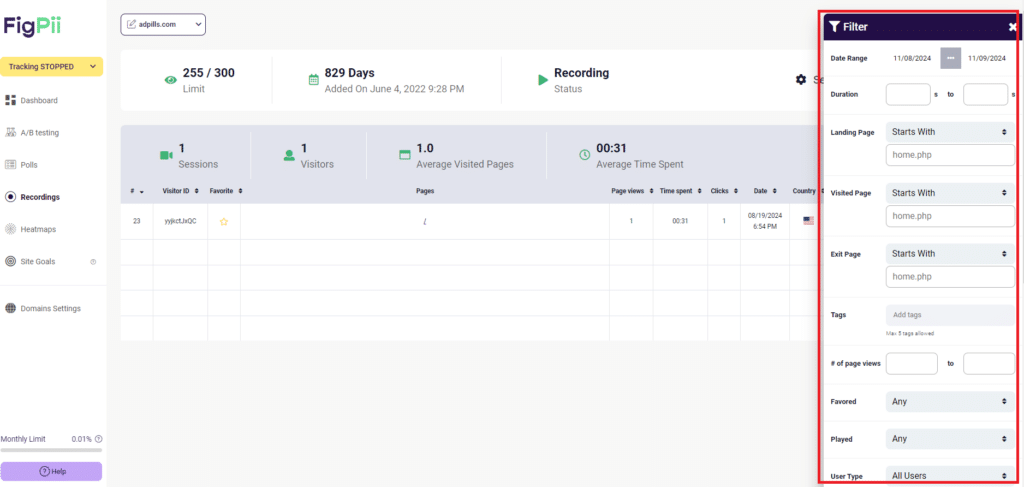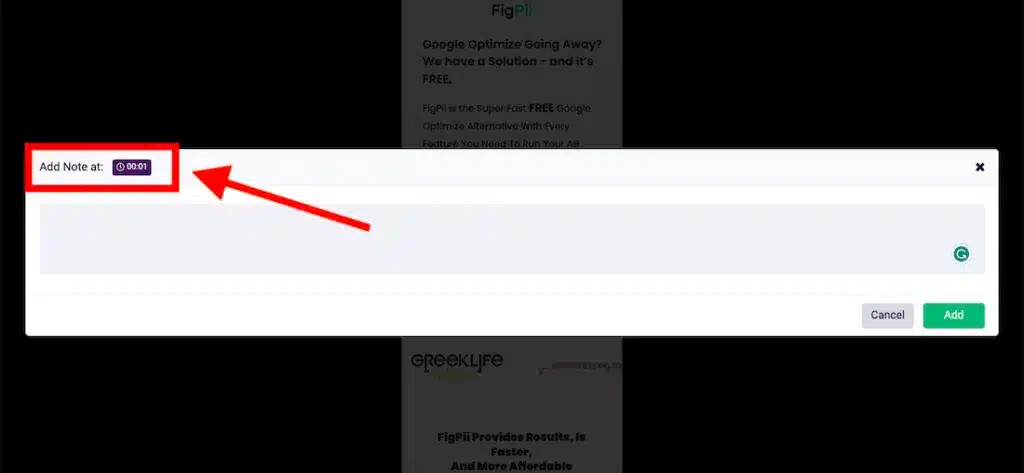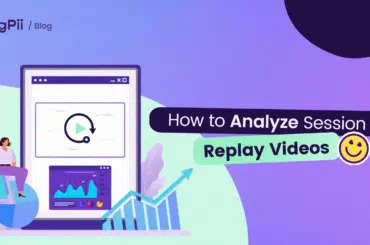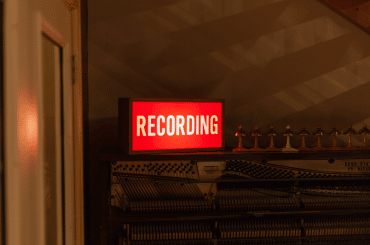Almost every store these days installs CCTV cameras to monitor what’s happening—whether it’s catching shoplifters or spotting areas where customers get stuck.
Session recordings serve a similar purpose for websites. They allow you to watch how visitors interact with your site, revealing where things go smoothly and where they don’t.
This article will explore how analyzing session recordings can help you identify hidden issues and improve the user experience.
What are Session Recordings?
Session recordings are software tools that capture real-time user interactions on your website, tracking actions like clicks, scrolls, form submissions, and navigation paths.
These recordings offer a direct look at how visitors experience your site, whether they navigate smoothly or encounter obstacles.
This raw data provides valuable insights into user behavior, helping you see what works and where improvements are needed.
Importance of Session Recordings Analysis
-
Identify User Pain Points
Session recordings offer a direct view of where users encounter difficulties on your website, whether confusing navigation, broken links, or unclear CTAs.
By watching users struggle with these elements, you can pinpoint specific areas for improvement.
For example, repeated clicks or frustration clicks can highlight design issues that might not be obvious in standard analytics, allowing you to prioritize critical fixes that will have the most significant impact.
-
Improve Conversion Rates
Session recordings reveal where users abandon key processes, such as the checkout page or a sign-up form.
Understanding exactly where users drop off allows you to optimize these touchpoints. If users consistently abandon their carts, there may be issues with the payment flow, which can be fixed.
Minor adjustments, like simplifying a form or removing unnecessary form fields, can lead to higher form conversions when you tie changes to what you observe in the recordings.
-
Understand Real User Behavior
Assumptions about how users interact with your site often differ from reality. Session recordings show you the real picture, clearly understanding how users navigate, where they spend time, and which elements they engage with.
This insight helps you optimize content placement, streamline navigation, and ensure that important features are visible and accessible. Knowing how users truly behave on your site is key to creating a user experience that meets their needs.
-
Validate Hypotheses from Other Data Sources
While tools like Google Analytics and heatmaps provide valuable data, they often lack the context needed to understand why certain user behaviors occur.
Session recordings add this missing layer, confirming or challenging hypotheses drawn from these other sources.
For instance, heatmaps might show that a button gets a lot of clicks, but session recordings will show whether users clicked it out of frustration or intent. These insights lead to more innovative, data-driven decisions.
-
Helps Improve Customer Support and Reduce Complaints
Common user issues often surface in session recordings before they become formal complaints.
Businesses can address potential support issues early by spotting trends in user frustration, such as difficulties finding information or completing actions.
This proactive approach reduces the volume of customer service requests and improves the user experience by resolving pain points before they escalate into larger problems.
How to Analyze Session Recordings
Analyzing session recordings requires a clear process. By setting goals and using a structured approach, you can focus on finding patterns and identifying key issues.
This section will discuss the steps involved in effectively reviewing session recordings.
-
Define Goals
It is important to set clear goals before analyzing session recordings. Having specific objectives ensures that your analysis is focused and productive.
When you know your goal, you can filter and watch recordings that directly support those goals.
Here are some practical examples of goals you might focus on:
- Increase form submission rates: Identify where users abandon forms and why they fail to complete them.
- Reduce cart abandonment: Pinpoint where users leave during the checkout process.
- Improve navigation flow: Understand if users are getting lost or taking inefficient paths through your website.
- Boost engagement: Observe if users interact with key elements like buttons, links, or media.
- Reduce bounce rates: Understand why visitors leave after viewing only one page and identify ways to keep them engaged.
-
Avoid distractions and interruptions.
Maintaining uninterrupted focus is essential when analyzing session recordings. Even small distractions can cause you to overlook important details that reveal critical user behaviors or issues.
However, while it’s easy to say “avoid distractions,” the reality is that it’s not always possible to eliminate them.
When distractions happen, it’s important to pause the recording to ensure you don’t miss any key moments.
Taking a quick note of where you left off can help you get back on track quickly.
Additionally, consider blocking off dedicated time for your analysis and minimizing external noise or interruptions, like using headphones or setting a distraction-free workspace.
This way, you can quickly resume without losing focus even if disruptions occur.
-
Filter Session Recordings to Watch Based on Your Goals
Choosing the right session recordings to watch is key to productive analysis. Rather than randomly selecting sessions, focus on those that align with your set goals.
For example, if your goal is to reduce cart abandonment, prioritize sessions in which users reach the checkout page but don’t complete the purchase.

Using filters can help narrow down the recordings to the most relevant ones. You can filter based on session length, specific pages visited, user behavior (e.g., rage clicks), or device type.

FigPii’s Session Recording; Using filters to choose session recordings
This approach ensures that you are not overwhelmed with unnecessary data and can focus on the sessions that will provide the most valuable insights.
Staying targeted with your selection helps you identify the key patterns and issues related to your goals, making the analysis much more effective.
-
Take Notes While Watching
Taking detailed notes during session recording reviews is crucial for capturing valuable insights. Documenting user difficulties, unexpected behaviors, repetitive issues, and key patterns helps ensure that nothing is missed.

Important observations may slip through the cracks without proper notes, making it harder to act on the insights you gather.
Here are some tips for effective note-taking during your analysis:
- Organize by patterns: Group similar user behaviors and issues to identify recurring problems quickly.
- Use timestamps: Mark specific moments in the recording for easy reference later.
- Tag key insights: Create tags or categories (e.g., “form issues,” “navigation errors”) to make your notes actionable and easier to share with your team.
Consider using tools like spreadsheets or tagging systems to organize your notes and make them actionable. Structured notes will help you easily reference key moments, share insights, and prioritize improvements effectively.
-
Validate Observations With Other Qualitative Data
Session recordings provide valuable insights, but combining them with qualitative data from tools like heatmaps creates a more complete picture of user behavior.
Heatmaps show where users click most often, how far they scroll, and which areas of a page receive the most attention.
These aggregated insights can confirm trends spotted in session recordings and help clarify why certain behaviors occur.
For example, if users repeatedly click on a particular area, heatmaps can reveal whether it’s a common pattern across multiple sessions.
This cross-validation ensures you’re acting on well-rounded data, making your decisions more accurate and impactful.
-
Identify and Prioritize Issues
Once you’ve reviewed session recordings, the next step is identifying the issues users face. These could be usability problems, navigation bottlenecks, or areas where users tend to drop off.
By pinpointing where users get stuck or frustrated, you can begin to prioritize which problems to tackle first.
A helpful framework for prioritizing issues involves evaluating them based on the following;
- Business impact: Focus on issues affecting revenue, conversions, or key performance metrics.
- User frequency: Prioritize problems that affect a large number of users.
- Severity: Address critical issues that cause major disruptions or prevent users from completing tasks.
For example, fixing a critical issue affecting many users, like a broken checkout process, should come before smaller design tweaks.
Collaboration with teams such as UX, developers, and product managers is essential to ensure that identified issues are addressed efficiently and effectively.
This joint effort ensures that improvements are implemented smoothly, resulting in a better user experience.
-
Use Findings to Inform Design Improvements and Optimize the Website
Session recordings provide actionable insights that can lead to meaningful design improvements. For example, if users frequently abandon complex forms, simplifying them can improve completion rates.
Similarly, if navigation confuses users, restructuring your menus may enhance the user journey.
These insights can also guide larger optimizations, such as redesigning problematic sections of your site.
Once changes are made, running A/B tests ensures you can compare performance and validate the improvements.
Optimization is an ongoing process. After implementing changes, analyze new data and repeat the cycle of testing and refining, ensuring continuous improvement in the user experience.
The ultimate goal of session recording analysis is to make informed, data-driven improvements to your website. This approach gives you a deeper understanding of your users’ needs and frustrations, enabling you to enhance the user experience and drive better results over time.
Best practices for analyzing session replay videos
To get the most value from session replay videos, it’s adviceable to follow best practices that ensure your analysis is efficient and insightful.
These practices help you focus on the right data, draw meaningful conclusions, and turn insights into actionable improvements.
-
Watch Multiple Sessions
Watching multiple session recordings is important to identify consistent patterns in user behavior. Focusing on just one session can lead to misleading assumptions, as it may not represent the broader user experience.
Watching several recordings helps you spot trends and recurring issues, whether it’s users struggling with the same navigation element or frequently abandoning a particular page.
-
Use Filters to Focus on Key Sessions
Applying filters such as session duration, pages visited, or user actions helps you prioritize relevant sessions aligned with your goals. Focusing on recordings that highlight clear issues or match specific objectives saves time and improves efficiency in your analysis.
-
Combine Session Replays with Other Data Sources
Cross-referencing session replays with data from tools like heatmaps, Google Analytics, and conversion rates offers a more complete view of user behavior. Using multiple data sources ensures informed decisions, reducing the risk of acting on incomplete information.
-
Look for Unusual Behavior Patterns
Identifying outliers like rage clicks, abandoned forms, or repeated visits to the same page can uncover hidden issues. These unusual behaviors often reveal problems that are not apparent in aggregate data.
-
Take Detailed, Structured Notes
Documenting key observations, such as user actions, pain points, and areas of confusion, is crucial during analysis. Use consistent formats or tools, like spreadsheets, to keep notes organized and actionable for later optimization efforts.
Conclusion
Session recordings give you a front-row seat to how users interact with your website, showing where they struggle and what’s working well.
When combined with other data sources like heatmaps or analytics, these insights can guide you in making smart, impactful changes.
Focus first on the most common pain points to reduce friction and boost the overall user experience.
Remember, analyzing recordings regularly keeps your site running smoothly and ensures you’re constantly adapting to user needs.




